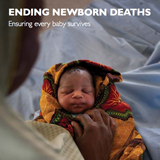
The world has made remarkable progress in the fight to end child mortality in recent years. Since 1990, we have almost halved the number of children who die every year before the age of five – from 12.6 million to 6.6 million.1
This amazing achievement – even more impressive given that the populations in the poorest countries have grown by 70% during this period2– allows us to start to imagine a world where no child is born to die from easily preventable causes.
And yet, in spite of this progress, child mortality remains one of the great shames of our modern world. Every day, 18,000 children under five die, and most from preventable causes.
Newborn Crisis Threatens Progress
This reduction in child mortality has been achieved through action on immunisation, family planning, nutrition and treatment of childhood illnesses, as well as improving economies. However, far less attention has been paid to tackling the life-threatening dangers children face when they are newborn and most vulnerable – at birth and in their first month of life.
This report shows that, in 2012, 2.9 million babies died within 28 days of being born: two out of every five child deaths. Of these, 1 million babies died within 24 hours, their first – and only – day of life.3
Causes of these deaths include premature birth, complications during birth and infections. This is heart-breaking and unacceptable.Unless we urgently start to tackle deaths among newborn babies, there is a real danger that progress in reducing child deaths could stall and we will fail in our ambition to be the generation that can end all preventable child deaths.
This report also reveals that the crisis is much bigger than we might think. in 2012 there were another 1.2 million tragic losses: stillbirths where the heart stopped beating during labour. These are not part of the fourth UN Millennium Development goal, which aims to reduce child mortality by two-thirds. However, they deserve to be counted in future maternal, newborn and child health frameworks, especially to understand the specific risks around labour and delivery. This report therefore focuses on the 2.2 million combined newborn deaths on the first day and stillbirths during labour.
- Executive Summary: Ending Newborn Deaths: Ensuring every baby survives (English)
- Resumen Ejecutivo: Acabernos Con Las Muertes Neonatales: Aseguremos la supervivencia de todos los bebés (Spanish)
- Résumé: Mettre fix aux décès des nouveau-nés: Garantir la survie de chaque enfant (French)
Photo: Jordi Matas/Save the Children
2014: The Opportunity for Life-saving Change
2014 will be a crucial year. Political support for universal health coverage – the availability of a basic package of healthcare for everyone, a package which countries can increase as resources increase – is growing around the world. The best place to start is by ensuring that no family, however poor, is denied life-saving care at birth.
And for the first time ever, countries and institutions around the world will sit down to agree an ‘Every Newborn Action Plan’, an agreement to tackle this deplorable problem of lack of attention to babies in their first days of life. Save the Children is working to ensure that this plan is ambitious and robust enough to end all preventable newborn deaths as well as tackle stillbirths during labour.
However, a plan on paper is not enough. it must be followed by concerted political action at the highest levels to achieve its implementation. Stopping newborns dying unnecessarily and preventing stillbirths, and hugely accelerating progress towards ending child and maternal mortality, will require a substantial change in our approach to health services.
This change must happen in the countries where child mortality rates are high, in partnership with donors and other stakeholders. We need a new sense of purpose from the global community. The world must not squander the opportunity that 2014 offers.
The Newborn Promise
Save the Children is calling on world leaders, philanthropists and the private sector – this year – to commit to a Newborn Promise to end all preventable newborn deaths:
- Governments and partners issue a defining and accountable declaration to end all preventable newborn mortality, saving 2 million newborn lives a year and stopping the 1.2 million stillbirths during labour6
- Governments, with partners,must ensure that by 2025 every birth is attended by trained and equipped health workers who can deliver essential newborn health interventions
- Governments increase expenditure on health to at least the WHO minimum of US$60 per capita to pay for the training, equipping and support of health workers
- Governments remove user fees for all maternal, newborn and child health services, including emergency obstetric care
- The private sector, including pharmaceutical companies, should help address unmet needs by developing innovative solutions and increasing availability for the poorest to new and existing products for maternal, newborn and child health.